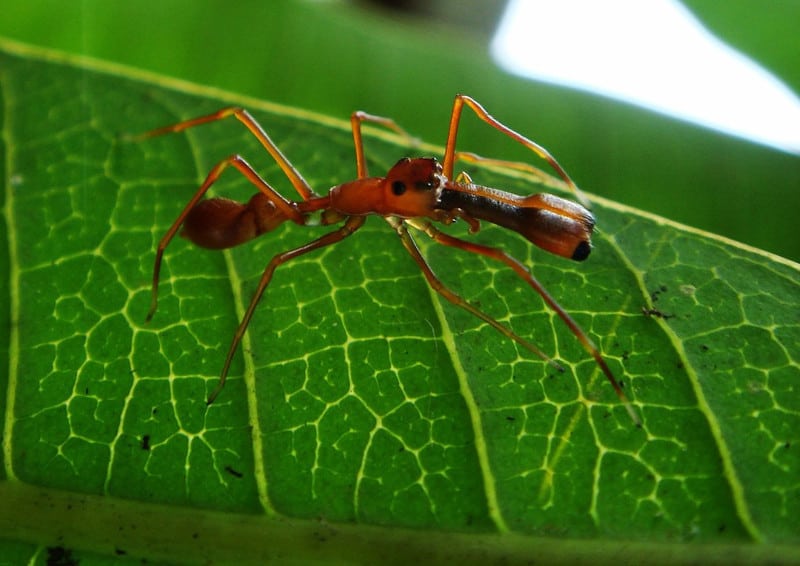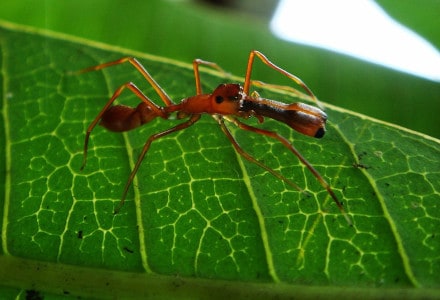
Kerengga ant-like jumper Facts
- This remarkable invertebrate bears the cumbersome common name of the Kerengga ant-like jumper. Though this term’s a mouthful, it’s nothing compared to the scientific name of the creature. That’s because its technical name is Myrmaplata plataleoides.
- Neither name rolls off the tongue easily, to be certain. Each also fails to properly prepare one for a startling fact, though one of them does provide a hint. That’s true because this creature isn’t an ant at all. In fact, it’s actually an incredibly evolved spider!
- The respected English clergyman and zoologist, Octavius Pickard-Cambridge made the first recorded scientific notation of the astonishing arthropod. He further accomplished this action in the year 1869, earning a respected spot in the halls of science.
- Fortunately for it, the amazing arachnid appears to have a population that’s both stable and sufficient in size. That status also appears to hold true throughout the entirety of its natural range. The IUCN, therefore, has no listing for it on the organizations Red List.
- The Kerengga ant-like jumper nevertheless does face several potential threats to its existence. In this respect, however, it’s only mirroring the situation faced by countless other forms of life around the planet. Both involve its habitat and environment.
- In its case, much like many other creatures, potential loss of habitat forms an ever-present danger. This holds especially true given its range. This likely presently forms its greatest threat. Like all other species, though, it’s also vulnerable to climate change.
Related Articles
Kerengga ant-like jumper Physical Description
The breathtaking work of evolution and Nature known as the kerengga ant-like jumper truly merits appreciation. That appreciation, however, isn’t earned solely for its distinctive form. In point of fact, this remarkable arthropod displays several very fascinating attributes.
It bears noting, first of all, that like many related species, it displays the physiological characteristic known as sexual dimorphism. In its case, however, this attribute manifests itself in not one, but in several ways. This arachnid truly takes camouflage to the next level.
Males of the species typically attain a greater overall length than their female counterparts. These reach an average body length measuring 0.35 – 0.47 in (9 – 12 mm). The females of the species, meanwhile, typically attain measurements of roughly 0.24 – 0.28 in (6 – 7 mm).
Coloring also varies between the genders. Males more commonly display various shades of light and dark brown. The females, on the other hand, generally display much lighter and more uniform shades. Both have two small dark patches on the head, resembling eyes.
The Kerengga ant-like jumper carries its camouflage even further, though. The body itself preseents the illusion of segmentation, like that of an ant. In reality, its abdomen and cephalothorax are simply constricted. Its two front legs also resemble an ants’ antennae.
- Kingdom: Animalia
- Phylum: Arthropoda
- Class: Arachnida
- Order: Araneae
- Family: Salticidae
- Genus: Myrmaplata
- Species: M. plataleoides
Kerengga ant-like jumper Distribution, Habitat, and Ecology
One factor helping the Kerengga ant-like jumper to survive in this time of climactic upheaval is its distribution. That’s due to the fact that it evolved as native to a comparatively broad section of the globe. More precisely, the spider appears in many regions throughout Asia.
Though present in large sections of the vast continent, the population of this arachnid remains principally confined to the southeastern portion. This primary zone of habitation mainly covers several countries. These consist of India, Sri Lanka, Thailand, and Singapore.
Within that range, though, the vast majority of its numbers make their home in the regions of dense foliage and high precipitation levels. There, though, it further prefers one of two specific locations. These consist of either bushes or trees, of various local species.
That specific preference exists because of its camouflage. Its appearance strongly mimics local weaver ants, who make their colonies in the same locations. The creature thereby gains a measure of protection from its own predators, most of whom shy away from the ants.
The Kerengga ant-like jumper itself also avoids the ants, and does not prey on them. Instead, it ambushes other small prey in its hin web. Its mimicry even exends to moving like the ants, including waving its two front legs, copying the motion of the ant’s two antennae.
As its name implies, this marvelous arachnid evolved as a variety of what’s known as a jumping spider. This particular species, however, rarely employs that distinctive method of locomotion. To maintain its camouflage, it only jumps if it finds itself greatly imperiled.
Species Sharing Its Range
Check out our other articles on 3 Captivating Caves of Asia, Bonnethead Shark, Christmas Island, Anegada ground iguana, Flying Duck Orchid, Hyacinth Macaw, Purple Frog

